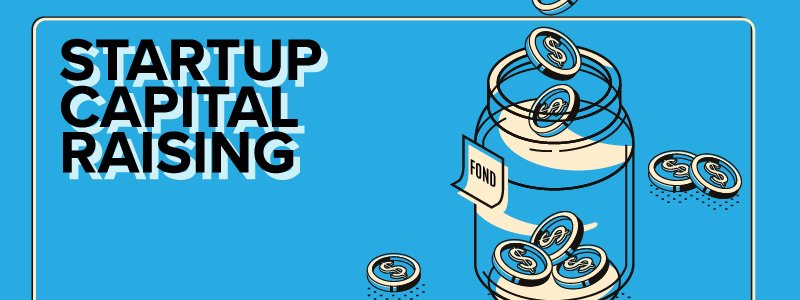Finding funding for your startup can be a time-consuming, difficult process. Here’s what you need to know about capturing startup capital in Australia.
Getting your startup off the ground means finding startup funding in Australia. Securing startup funding is critical to the success of any new venture — launching a new business requires focus, commitment, patience, and, most of all, the money to get your business idea out into the marketplace.
The Australian startup ecosystem is complex. Determining where to start when seeking funding for your startup concept can rapidly become a headache. Australian entrepreneurs hunting for startup capital are provided with a range of different options, ranging from venture capital, to accelerator funding, and government grants to more complex funding sources such as R&D tax incentive financing.
This guide will break down the twelve most viable options for startup funding in the Australian startup ecosystem.
1. Venture Capital
Venture capital is one of the most widely used and popular methods of capturing startup funding in Australia in the startup ecosystem.
Venture capital funding is provided by venture funds, which are invested in by high net worth individuals, corporate entities, giant super funds, and other groups. These venture funds, which are managed by investors, invest in promising startups in return for equity stakes.
VC funds are, in most cases, interested only in startups that present high growth potential. Return on investment isn’t the only factor that venture capital funds consider when investing in a startup, however. VC firms often specialize in specific industries or verticals, preferring to invest in startups that operate within their area of expertise. It’s also common for VC firms to work closely with startup founders, joining the board of startups they invest in.
Funding rounds led by or contributed to by VC firms can provide significant capital. Australian funding rounds in 2020, for example, saw $1.7 billion invested in Australian startups. Melbourne-based fintech startup Airwallex, for example, captured $148 million AUD in a 2019 funding round alongside Canva, which secured $85 million USD.
With the average value of VC deals increasing across Australia in 2019, the Australian VC funding environment is a promising option for startups seeking traditional VC funding in return for equity despite the ongoing COVID-19 pandemic and economic slowdown.
2. Angel Investors
Angel investors, like VC firms, are primarily high net worth individuals that possess expertise or interest in a specific industry, vertical, or technology. Unlike VC firms, however, angel investors operate as individuals. In some cases angel investors may combine their investing efforts through an angel group.
Angel investors operate in a very different manner than VC firms, preferring to take a hands-on approach to the operation and growth of the startups they invest in. Working with an angel investor can provide early stage startups with critical business connections, skills, expertise, and knowledge that propels their business toward success.
One drawback of angel investors is the frequency at which they invest in the startup ecosystem — angel investors are unlikely to direct capital towards new startups during a tight economy. The ongoing COVID-19 crisis has had a profound impact on the rate at which angel investors participate in funding, with overall angel investor funding dropping by 22 percent in March 2020 alone.
Angel investors are, however, much faster than traditional VC funding. Securing seed startup funding in Australia through angel investors is typically a faster process than capturing funding through VC firms due to the close relationships established between angel investors and startup founders.
3. Debt Funding
Debt funding is a startup funding method that provides new businesses with a cash injection that doesn’t require trading equity for capital. Rather than exchange equity for funding, debt funding provides a startup business with capital that must be repaid over a set period.
There are a number of debt funding options available to Australian startups — Australian venture capital firm OneVentures launched a $100 million venture credit fund in August 2018, for example.
Unlike traditional equity investments, debt funding provides startup founders with the opportunity to capture startup capital in Australia without diluting their ownership over the business. The downside of debt funding, however, is that finance comes with interest costs. In many cases, debt funding also requires that startup founders offer up their business as a security.
While non-dilutive funding options are attractive to startups seeking the capital they need to launch, it’s important to carefully assess the terms of any debt funding option to ensure that they align with the long-term goals of your startup.
4. R&D Tax Incentive Financing
R&D finance is a largely unrealised means of startup funding in Australia, and is commonly overlooked by startups seeking funding due to its complex nature. R&D tax incentive funding is a new type of financial instrument that leverages the future R&D tax incentive payments as collateral for a debt facility.
Many Australian companies are able to take advantage of the R&D tax incentive, but are unable to leverage the capital it provides at early business stages due to the slow disbursement process. If you’re not sure how the R&D tax incentive works, you may want to review the Fullstack guide to the R&D Tax incentive: How it Works.
In order for a company to access the R&D tax incentive, it’s necessary to spend capital on R&D in the current financial year, prepare accounts at the end of the financial year, and then file an R&D tax credit claim as part of an annual income tax return. This process typically takes 6 to 12 weeks after filing to complete.
R&D financing allows startups to access the funds provided by the R&D tax incentive in the year in which R&D spending occurs. For more information on the R&D tax incentive and how it may help you launch your startup, review Fullstack’s managed R&D Tax Incentives solutions.
5. Bootstrapping
Bootstrapping your startup can be the most difficult means of launching a new venture — but it can also be the most rewarding. Bootstrapping means launching your startup with your own cash and sustained revenue. In simple terms, bootstrapping means cutting costs wherever possible, devising innovative means of solving problems without excessive expenses, and remaining as lean as possible through critical growth stages.
Startups that choose to bootstrap their ventures may, in some cases, restrict the speed at which their business scales, but they gain a critical advantage — bootstrapped startups don’t need to dilute their equity in early stages, placing them in a highly secure position once their business takes off.
Importantly, bootstrapped founders are wholly independent and aren’t obligated to consider the opinions or input of any other parties when making business decisions. A startup that is able to bootstrap for an extended period will possess more equity to distribute should they choose to pursue equity funding at a later date.
Sydney-based unicorn startup Atlassian, for example, bootstrapped for eight years before raising $60 million in 2010, with another funding round in 2014 securing $150 million. Now listed on the NASDAQ stock exchange, Atlassian has a market cap of $41.2 billion.
6. Accelerator Funding
Accelerator programs are sources startup funding in Australia that provide startups with professional guidance, assistance, and networking in addition to startup capital. A startup accelerator program functions as a critical launchpad into the ecosystem that can deliver a critical advantage to new businesses.
Most startup accelerators are focused on a specific industry or market segment — programs will provide access to industry experts or mentors, advice, networking opportunities, and a strong sense of community amongst startup cohorts.
Some Australian startup accelerators offer participants a modest amount of funding in exchange for equity. Sydney-based Slingshot Accelerator, for example, offers promising startups seed funding and access to a network of corporate partners.
Startmate, another Australian startup accelerator, offers a 12-week startup program, while Brisbane-based iLab provides a variety of programs that include a three-month training and mentoring program that provides up to $20,000 in funding to select startups.
7. Government Grants
Depending on the nature of your startup, your business may be eligible for a wide range of government grants and tax incentive rebates. Government grants can provide your business with critical startup funding, but eligibility and application processes can be complicated.
Government funding can be split into two broad categories — upfront grants, and tax incentives. Grants typically require startups to apply with justification for the grant and are only available to businesses that meet specific eligibility requirements. Tax incentives are available to startups that meet different criteria, and are typically claimed at the end of the financial year.
High value grants provided by the Australian government are typically offered at a federal level, and have relatively high competition. State-level grants may offer less funding, but are often less competitive. Tax incentives are not competitive when compared to grant programs, requiring only that startups meet eligibility and compliance rules.
8. Corporate Venture Funds
Corporate venture funds operate in a similar manner to venture capital funds. The key difference between the two is that a corporate venture fund is backed by a corporate entity, such as a financial institution or insurance company that focuses on investing in promising startups relevant to the industry they operate in.
Corporate venture funds allow corporate entities to experiment in the innovation space, testing new technologies, or identifying and integrating disruptive technology in a forward-leaning stance. While corporate funds may focus on fostering development in the industry they operate in, they’re still concerned with capturing a return on investment, and thus support only highly promising startups.
IAG insurance, for example, launched the Firemark Labs venture fund and accelerator program in 2016, and focuses on investing in promising insurance and insurtech startups. By launching separate venture fund arms, slow-moving corporate organizations are able to keep up with the rapid innovation of the startup ecosystem.
9. Equity Crowdfunding
Equity crowdfunding is a relatively new development in startup funding in Australia and was given approval by the Federal Parliament in 2017 after two years of industry consultation, deliberations, and debate. Equity crowdfunding allows individuals to invest small amounts of capital into companies for small amounts of equity.
In September 2018, equity crowdfunding rules were relaxed, opening the doors to equity crowdfunding for startups and private companies. The opportunity to raise capital through equity as a private company does complicit matters, however, and in many cases can generate additional expenses.
Startups considering equity crowdfunding should carefully consider the balance between including customers in the startup funding process and creating a viable business.
10. Crowdfunding
Crowdfunding may not now be as popular as it once was before the launch of new equity crowdfunding rules, but there are still several Australian startups that have used “traditional” crowdfunding practices to launch a new venture through platforms such as Kickstarter.
Crowdfunding campaigns present backers with the opportunity to pledge a specific amount of capital to a business now in order to receive a product or credit at a later date. Importantly, there’s no equity involved in traditional crowdfunding — and funds are only taken from consumers if the amount of capital pledged by backers reaches a predetermined threshold.
Kickstarter and other crowdfunding platforms are now not as popular as in the mid-2016 Kickstarter rush in which Australian platforms raised millions through the platform, such as Nura’s 2.5 million, 8000 backer campaign — but crowdfunding still remains a viable option for startups seeking an alternative to equity funding.
11. Blockchain-Based Crowdfunding
Blockchain-based crowdfunding exploded into the startup ecosystem during mid-2017, with thousands of enterprising ventures around the world launching startups via the initial coin offering, or ICO model. The ICO model, now the subject of strict regulation, provided investors with the ability to purchase blockchain tokens prior to the development and launch of a platform, with some capturing hundreds of millions in startup capital.
While cryptocurrency prices are now recovering, the ICO and blockchain crowdfunding model has yet to adapt to a slew of regulatory movements that have restricted the once-unregulated sector. Operating an initial coin offering in Australia is now a complex process, involving obligations under the Corporations Act 2001 and to the Australian Securities and Investments Commission Act 2001.
The Australian government now provides detailed guidance to Australian startups seeking funding via initial coin offerings.
12. Friends and Family Funding
Friends and family funding is a highly popular fallback for very early stage startups, allowing startup founders to capture startup capital through the assistance of their immediate network.
Bringing issues of money and equity into personal relationships can be complicated, however — it’s important to draw up the correct paperwork professionally and ensure all expectations are handled in a transparent manner.
Key Takeaways
Capturing the funding your startup needs to launch can be a complicated and difficult process. Equity funding can deliver large amounts of capital on a relatively fast schedule, at the cost of diluting ownership or creating friction between key stakeholders.
Bootstrapping your startup provides full ownership over your business, but creates financial obstacles that must be overcome before a venture can scale and grow. Ultimately, there’s no ideal solution to funding your Australian startup — it’s important to take into account your key goals and vision, and work with a funding method that aligns with your business.
Navigating the complex startup funding ecosystem can be daunting for new founders. If you’re needing seasoned expertise for your capital raise or help with government grants like the R&D Tax Incentive, reach out to the startup accountants at Fullstack today.
Was this article helpful?
Related Posts
- Startup Funding
Getting your startup funding is an essential skill for most tech startup founding teams. However…
- Finding a Co-Founder in Australia
The success of your startup in Australia hinges on choosing the appropriate co-founder. This article…
- Startup Guide in Mergers and Acquisitions
Navigating the intricate landscape of mergers and acquisitions (M&A) is a critical endeavor for startups…
- Startup Funding
Getting your startup funding is an essential skill for most tech startup founding teams. However…

















